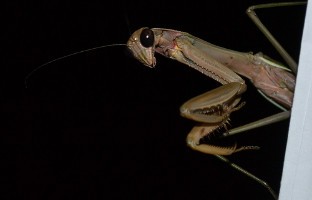The stranger at prayer

At the park a few weeks ago, I clambered up the playground
ladder, pursued by my son. At the top I turned to meet a praying mantis face to
face. It was small and perched on the smooth, domed top of one of the playground's
structural pillars. It looked very much out of place.
"Soren, come look at the praying mantis," I urged my son,
drawing on a reservoir of science nerddom that I thought had been drained
before high school. I picked him up so he could see the creature eye to eye. I
explained that the insect was named for its front legs, which look like they
are joined in prayer.
Soren came back for a few more glances between trips down the
slide. I, on the other hand, was transfixed. How had this thing gotten up
there? How would it get down? It appeared to be looking at me. What was I to it,
I wondered?




